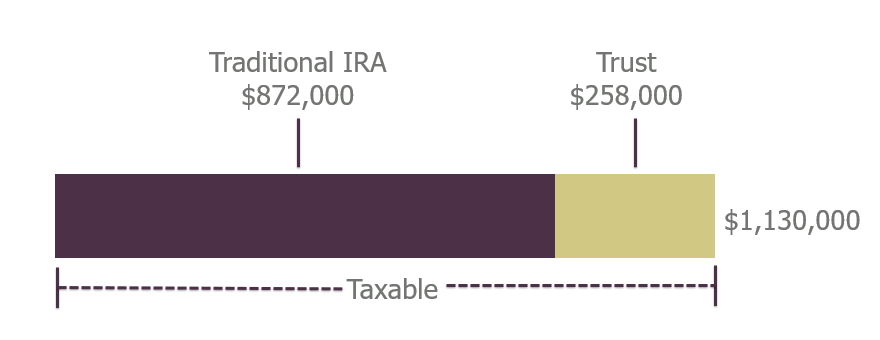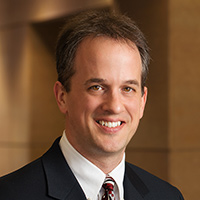Is There a Right Way to Make a Roth Conversion?
Converting some of your traditional IRA funds into a Roth can be a great strategy as you approach retirement. But be careful about how you incorporate such a move into your retirement withdrawal plan.


A commonly recommended strategy for reducing your tax burden and the impact of required minimum distributions (RMDs) is a Roth conversion. You’ll have no trouble finding information on why you should consider converting pretax IRA money to a Roth IRA in a low-income year. Simply put, a Roth IRA lets people at least age 59½ withdraw money tax free and is not subject to RMDs. But, what may be harder to find is a demonstration of how to fully maximize a Roth conversion’s potential benefits.
Keep in mind though, each person’s financial situation is different, meaning a Roth conversion doesn’t make sense for everyone. Since you must pay income taxes on the amount you convert to a Roth, it’s ideal to do it in a low-tax year. Some retirees who live off of a steady annual income throughout retirement may never have a low-tax year. So, a series of Roth conversions would only add to their taxable income and potentially push them into a higher tax bracket.
An example would be traditional IRA owners who have no income other than Social Security. As it’s unlikely Social Security is enough to cover all of one’s retirement expenses, it’s safe to assume you would need to supplement it with a regular withdrawals from your IRA each year. Thus, a Roth conversion would only increase your annual income and, subsequently, your tax burden.
From just $107.88 $24.99 for Kiplinger Personal Finance
Become a smarter, better informed investor. Subscribe from just $107.88 $24.99, plus get up to 4 Special Issues

Sign up for Kiplinger’s Free Newsletters
Profit and prosper with the best of expert advice on investing, taxes, retirement, personal finance and more - straight to your e-mail.
Profit and prosper with the best of expert advice - straight to your e-mail.
Nonetheless, there are many retirees who would be better off making a multiyear Roth conversion.
One couple’s story illustrates the Roth strategy
I find the best way to understand complex subjects such as this is through a story. Therefore, I would like to explore this strategy with a fictitious couple, but with actual dollar amounts. Everyone, meet John and Jane.
John and Jane are a retired, married couple who file their taxes jointly. They both turn 62 this November and will file for Social Security payments in January of next year. Together, they will receive $35,000 per year from Social Security. At the end of this year, they will have $750,000 in a traditional IRA and $250,000 in a trust.
John and Jane
Retirement date: Age 62
Combined Social Security benefit: $35,000/year
Assets:
- Traditional IRA: $750,000
- Trust: $250,000
Working with their financial adviser, John and Jane set a goal to keep the size of their retirement assets approximately the same as they approach age 90. They want to live a comfortable retirement but also leave some money to their children and grandchildren. They determine that given a 2.25% cost-of-living adjustment, they’ll have $70,000 in net income from savings and Social Security throughout their golden years. It’s also assumed that their accounts earn a pretax return of 5.9%. Now, let’s see how different strategies help them realize their goal.
Strategy 1: Drawing down assets proportionately
The first strategy they discuss is to take a proportionate withdrawal from both their IRA and trust money. Starting in January, they would take $28,000 in distributions from their IRA and $12,000 from their trust, which is about a 4% withdrawal rate. Adding in Social Security and subtracting taxes from their cash flow, they will have their annual target net income of $70,000. Throughout retirement, they will gradually increase both their trust and IRA withdrawals, keeping the IRA approximately three times the size of the trust.
At age 70½ though, they must start taking RMDs from their IRA. Because RMDs increase as you grow older, by age 85, their RMDs will be large enough that they can gradually cut back on trust distributions. Since they’ve withdrawn less than they earned, by age 90, they can expect to have $872,000 in their IRA and $258,000 in their trust, for a total of $1,130,000. The trust will still generate taxable income, and the IRA will still have unrealized taxes built in.
John and Jane’s assets by age 90

Strategy 2: Making a multiyear Roth conversion
The second strategy they consider involves a few different steps. From the time they retire at age 62 until age 70, they will live entirely off the trust account, preserving more money in their tax-sheltered IRA. In their first year, they withdraw $37,200 to pay expenses, including a tax bill of less than $1,000 that results from their Roth conversion. They will convert $15,000 per year for eight years from their IRA to a Roth. This keeps their taxable Social Security at or near $0. With the standard deduction, they will owe almost no income tax in their 60s.
Once they’re age 70, they should have approximately $1,030,000 in their IRA, $148,000 in a Roth and nothing left in the trust. When RMDs kick in, they will have to take the required amount plus a bit extra to still net them $70,000 per year, including income from Social Security. But, because they kept their IRA from growing too quickly in their 60s, through age 90, their RMDs remain smaller than what they need to take out to maintain their standard of living. The IRA will begin to shrink as they continue to take increasing distributions, but since the Roth account has been left alone, it will grow. By age 90, they have $1,159,000 in savings, 40% of which is in the Roth — tax free and with no RMDs in their lifetime.
Under this strategy, they end up with an extra $29,000 for retirement. But, the real victory is that $464,000 of their total savings is free and clear in a Roth account.
John and Jane’s assets by age 90

If John and Jane chose to convert their entire IRA to a Roth in their lifetime, they would need to double their annual conversions over those eight years to $30,000. Then continued distributions would eliminate their IRA by age 90, leaving $1,014,000 in the Roth. This is obviously a smaller portfolio than either of the previous scenarios, but the money is entirely tax free. This might benefit them depending on the income tax structure at that time or what’s best for their heirs.
As you consider your own strategy, be mindful that there are many balls to keep in the air. You have to understand the rules governing each account you own — qualified vs. non-qualified — as well as the taxability of your assets. Also, be wary of how your income will affect the amount of your taxable Social Security benefit. A Roth conversion can help keep more of your money working for you throughout retirement. But, this is a complicated calculation that may be best performed with the guidance of a financial adviser.
Profit and prosper with the best of Kiplinger's advice on investing, taxes, retirement, personal finance and much more. Delivered daily. Enter your email in the box and click Sign Me Up.

Sean McDonnell, CFP®, is a financial adviser at Advance Capital Management, an independent registered investment adviser based in Southfield, Mich. He works closely with clients to create and implement customized financial plans, as well as provides a wide range of services, including: investment and 401(k) management, retirement planning and tax strategies.
-
 The Santa Claus Rally Officially Begins: Stock Market Today
The Santa Claus Rally Officially Begins: Stock Market TodayThe Santa Claus Rally is officially on as of Wednesday's closing bell, and initial returns are positive.
-
 How to Leave Different Amounts to Adult Children Without Causing a Rift
How to Leave Different Amounts to Adult Children Without Causing a RiftHere’s how to leave different amounts to adult children without causing a family rift.
-
 My Retirement Learning Curve, 1 Year In
My Retirement Learning Curve, 1 Year InA retiree checks in with what they wish they knew early on and what they've changed about their plan one year in.
-
 Introducing Your CD's Edgier Cousin: The Market-Linked CD
Introducing Your CD's Edgier Cousin: The Market-Linked CDTraditional CDs are a safe option for savers, but they don't always beat inflation. Should you try their counterparts, market-linked CDs, for better returns?
-
 How to Protect Yourself and Others From a Troubled Adult Child: A Lesson from Real Life
How to Protect Yourself and Others From a Troubled Adult Child: A Lesson from Real LifeThis case of a violent adult son whose parents are in denial is an example of the extreme risks some parents face if they neglect essential safety precautions.
-
 To Build Client Relationships That Last, Embrace Simplicity
To Build Client Relationships That Last, Embrace SimplicityAs more automation becomes the norm, you can distinguish yourself as a financial professional by using technology wisely and prioritizing personal touches.
-
 Client Demand Is Forcing Financial Advisers to Specialize: How to Deliver
Client Demand Is Forcing Financial Advisers to Specialize: How to DeliverThe complexity of wealthy clients' needs — combined with AI and consumer demand — suggests the future of financial planning belongs to specialized experts.
-
 A Financial Planner Takes a Deep Dive Into How Charitable Trusts Benefit You and Your Favorite Charities
A Financial Planner Takes a Deep Dive Into How Charitable Trusts Benefit You and Your Favorite CharitiesThese dual-purpose tools let affluent families combine philanthropic goals with advanced tax planning to generate income, reduce estate taxes and preserve wealth.
-
 A 5-Step Plan for Parents of Children With Special Needs, From a Financial Planner
A 5-Step Plan for Parents of Children With Special Needs, From a Financial PlannerGuidance to help ensure your child's needs are supported now and in the future – while protecting your own financial well-being.
-
 How Financial Advisers Can Best Help Widowed and Divorced Women
How Financial Advisers Can Best Help Widowed and Divorced WomenApproaching conversations with empathy and compassion is key to helping them find clarity and confidence and take control of their financial futures.
-
 A Wealth Adviser Explains: 4 Times I'd Give the Green Light for a Roth Conversion (and 4 Times I'd Say It's a No-Go)
A Wealth Adviser Explains: 4 Times I'd Give the Green Light for a Roth Conversion (and 4 Times I'd Say It's a No-Go)Roth conversions should never be done on a whim — they're a product of careful timing and long-term tax considerations. So how can you tell whether to go ahead?